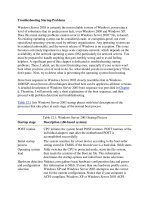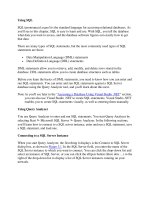HOTEL/RESTAURANT MANAGEMENT CAREER STARTER Phần 1 doc
Bạn đang xem bản rút gọn của tài liệu. Xem và tải ngay bản đầy đủ của tài liệu tại đây (113.65 KB, 16 trang )
HOTEL/RESTAURANT MANAGEMENT
CAREER STARTERHOTEL/RESTAURANT
MANAGEMENT
career
starter
Lauren Starkey
New York
Copyright © 2002 LearningExpress, LLC.
All rights reserved under International and Pan-American Copyright Conventions.
Published in the United States by LearningExpress, LLC, New York.
Library of Congress Cataloging-in-Publication Data:
Starkey, Lauren B., 1962–
Hotel/restaurant management career starter / Lauren B. Starkey.—1st ed.
p. cm.
ISBN 1-57685-411-6
1. Hotel management. 2. Restaurant management. I. Title.
TX911.3.M27 S6985 2002
647.94'068—dc21
2002001383
Printed in the United States of America
9 8 7 6 5 4 3 2 1
First Edition
ISBN 1-57685-411-6
For more information or to place an order, contact LearningExpress at:
900 Broadway
Suite 604
New York, NY 10003
Or visit us at:
www.learnatest.com
About the Author
Lauren Starkey is a writer and editor, specializing in educational and ref-
erence works, with over ten years of experience. For eight years, she worked
on the Oxford English Dictionary. She lives in Essex, Vermont, with her
husband, Gorden, and children, Emma, Graham, and Cameron.
Introduction Why Become a Hotel or Restaurant Manager? ix
Chapter One Choosing a Career as a Hotel 1
or Restaurant Manager
What is a Hotel or Restaurant Manager 2
What Do Hotel or Restaurant Managers Do? 3
What Makes a Great Hotel or Restaurant Manager? 5
Hiring Trends and Salaries 6
The Importance of Training 9
Where Do Hotel or Restaurant Managers Work? 11
Opportunities for Advancement 19
Certification 20
Skills Inventory 22
Chapter Two Getting the Education You Need 26
Why You Need Training 27
Types of Training Programs 28
Choosing a Training Program 39
Admission Requirements 47
Making the Most of Your Training Program 49
Chapter Three Financial Aid—Discovering the Possibilities 57
Some Myths about Financial Aid 58
Types of Financial Aid 60
Applying for Financial Aid 73
General Guidelines for Loans 79
The Most Frequently Asked Questions 83
about Financial Aid
Financial Aid Checklist 85
Contents
Financial Aid Acronyms Key 85
Financial Aid Terms—Clearly Defined 86
Financial Aid Resources 87
Chapter Four Finding Your First Job 94
What Kind of Job Do You Really Want? 95
Taking a Deadline-Oriented Approach 96
to Your Job Search Efforts
Researching the Field 97
Finding the Jobs Available 104
Networking 112
Chapter Five Job Search Skills 119
Writing Your Resume 120
Writing Cover Letters 146
Interviewing Successfully 150
Evaluating a Job Offer 158
Chapter Six Succeeding on the Job 163
Fitting Into the Workplace Culture 164
Managing Work Relationships 166
Stress on the Job 173
Managing Your Time 177
Mentors 180
Promoting Yourself 182
Moving On 187
Final Thoughts 189
Appendix A Professional Associations 193
Appendix B Additional Resources 195
Appendix C Directory of Accredited Schools, 203
National Accrediting Associations,
and Financial Aid by State
Appendix D Sample Free Application for Federal 219
Student Aid (FAFSA)
viii
Contents
types of programs and how to succeed once you have entered one. Sample
courses and tuition costs from schools across the country are also in this
chapter.
In Chapter 3, you will learn the possibilities for financing your education,
including loans, scholarships, and grants. The differences between each
option are explored, explaining eligibility, the application process, and how
awards are given. You will also find out about the forms you need, where to
get them, how to fill them out, and where to send them, and get some tips
for simplifying and surviving the process.
Chapter 4 covers the job search process, beginning with a discussion
about determining the type of job you really want. There is plenty of infor-
mation on where the best jobs are, and the best ways to find them, from clas-
sified ads to networking and Internet resources.
Then, in Chapter 5, you will learn how to hone your job search skills.
The crafting of winning resumes and cover letters that really get noticed is
explained, along with advice on how to handle interviews with more polish
and less anxiety. Finally, you will learn how to evaluate the job offers you are
sure to receive.
Chapter 6 takes you out of the job search and into the job market, show-
ing proven ways to succeed in your new position. You will learn how to man-
age relationships with your superiors and your employees, as well as how to
handle the stress that often accompanies work as a hotel or restaurant man-
ager. Other topics covered include fitting into the particular culture of your
new workplace, how to find a mentor, and how to promote yourself to get
ahead.
In addition, throughout the book, you will find insight and advice from
current hotel and restaurant managers. The appendices at the end of the
book offer helpful resources too: A list of professional associations, accred-
iting agencies, and state financial aid offices, as well as a directory of train-
ing programs. Also included are books and periodicals you can refer to for
additional information.
So, turn the page and begin. This book will give you a great start toward
a rewarding and challenging career as a hotel or restaurant manager.
x
Introduction
HOTEL/RESTAURANT MANAGEMENT
CAREER STARTER
agers whether they work on a cruise ship or a mountain lodge, a 1,000-room
city hotel, or a bed and breakfast in a college town. They include:
managing the hotel’s business plan or direction
hiring and training new staff
handling requests and complaints from guests
keeping records, planning budgets, and dealing with accounts
advertising the hotel and dealing with tour operators
supervising the day-to-day running of the hotel
taking bookings, greeting guests, and allocating rooms
devising the annual business plan for the hotel
having final say in quality and cost control
Restaurant managers are in charge of the food and service at a variety of
settings, including restaurants, hotel dining rooms, catering facilities,
healthcare sites, schools and other institutions. Depending on the employ-
er, a restaurant manager oversees all aspects of the operation, from choos-
ing the items that appear on the menu, to hiring and managing staff, to deal-
ing with record-keeping and payroll. As with hotel managers, the duties of
the restaurant manager rely somewhat on the type of establishment where
he or she is employed.
At large chain restaurants, the corporate owners make many of the deci-
sions regarding the operation of their facilities. They may plan the menus,
coordinate the suppliers of food, beverages, and other items, design the
décor, implement a marketing plan, and even determine the size and sched-
uling of the staff. The manager of such a restaurant is thoroughly trained by
the corporation and is expected to run the facility within strict corporate
guidelines.
Smaller restaurants give more responsibility to their managers. Instead of
having decisions made by corporate officers, most, if not all, of the decisions
are made in-house specifically for that restaurant. The manager of a small-
er restaurant must take a hands-on approach to the job, working with the
kitchen staff, the host or hostess, and the wait staff closely. When something
goes wrong, such as equipment failure, short staffing, or food spoilage, the
manager must step in and solve the problem.
4
HOTEL/RESTAURANT MANAGEMENT
career starter
nities for those entering the job market. Employers continue to primarily
seek out those with two- or four-year degrees in hospitality management.
Restaurant management positions across the country are expected to
increase by 10% to 20% through 2010. However, this percentage will be
much higher in large cities and tourist destinations. For example, the
California Labor Market Information Division projects that, in its state
alone, there will be a 45% increase in the number of restaurant managers
through 2005. This growth rate is almost twice the average for all occupa-
tions in the state. Most new restaurant management jobs will come from the
increasing number of dining establishments which cater to an ever-
expanding population. More and more schools, hospitals, company dining
rooms, and airports are contracting out food services, creating a large num-
ber of new positions for restaurant and food service managers.
Another trend affecting the employment of restaurant managers is the
dominance of national chain restaurants over independent ones. More new
restaurants are corporately owned, which means that the owner can’t be the
manager, as was frequently the case in independently owned restaurants.
Corporations such as Darden Restaurants (which owns Red Lobster and
Olive Garden) and Brinker International (Chili’s Grill and Bar, Romano’s
Macaroni Grill) employ thousands of managers to run their operations
across the country.
According to the Bureau of Labor Statistics, the median annual income
of hotel managers and assistants was $26,700 in 2000. The wide range of
salaries varies based on the job responsibilities of the manager and the area
of the hospitality industry in which he or she works. Many large, full-serv-
ice hotels routinely pay managers bonuses of up to 25 percent of their
salaries. Benefits may include such services as lodging, meals, parking, and
laundry, which can add up to substantial financial rewards. In addition, prof-
it-sharing, retirement plans, stock purchasing options, and tuition reim-
bursement are also part of the compensation packages of many employers.
The American Hotel and Lodging Association’s Education Institute
reports current average salaries as follows:
Reservations Manager $31,100
Executive Housekeeper $31,550
Front Office Manager $33,900
7
Choosing a Career as a Hotel or Restaurant Manager
Catering Sales Manager $35,600
Sales Manager $37,000
Chief Engineer $49,000
Human Resources Director $49,000
Senior Sales Manager $51,100
Controller $57,100
Food and Beverage Director $62,400
Director of Sales and Marketing $70,100
General Manager (non live-in) $97,300
General Manager $108,487
The Bureau of Labor Statistics reports that food service managers earned
an average of $31,720 in 2000, with the middle 50% earning between
$24,500 and $41,000. Their Occupational Outlook Handbook also breaks down
earnings by industry, as follows:
Miscellaneous amusement and recreation services $37,000
Hotels and motels $36,460
Nursing and personal care facilities $31,400
Eating and drinking places $31,380
Elementary and secondary schools $28,310
Benefits for restaurant managers vary with employers. The best packages
are usually offered by large employers such as corporations, which reward
their employees with profit-sharing plans, retirement savings plans, tuition
reimbursement, and comprehensive insurance coverage. In addition to such
typical benefits, many restaurant and food service managers are given free
meals and the opportunity for additional training.
According to a recent National Restaurant Association compensation sur-
vey, median annual salaries and bonuses (in parentheses) for food service
managers are as follows:
Banquet Manager $32,000 ($3,000)
Catering Manager $35,000 ($4,000)
Unit Manager $35,132 ($4,615)
Assistant Unit Manager $28,000 ($2,460)
8
HOTEL/RESTAURANT MANAGEMENT
career starter
lege credit. Many also run their own hotel or restaurant right on or near by
the campus, affording even greater hands-on, work-study learning opportu-
nities.
Todd Warren, who holds a degree in hospitality management, explains
the benefits of a work-study program:
There are a number of other advantages to be gained by the job candidate
with post-secondary training in hospitality management. Many schools hire
those working in the industry to teach their classes, putting their students in
contact with potential employers right away. Colleges and universities are
frequently the sites of job fairs, where employers gather to interview and
hire graduating seniors. They also maintain relationships with area busi-
nesses that hire their graduates, and thus become an invaluable resource for
job hunters.
All of this doesn’t mean you won’t be able to find a job if you haven’t or
can’t go to college, but that you may have a more difficult time than some-
one with a degree in hand. Because formal training is so important, we have
devoted two entire chapters of this book to the subject of your education and
how to pay for it. As you read through Chapter 2, remain flexible regarding
your ideas about education. You may think now that you would like to jump
into the job market right out of high school (and that may still be your
course of action after reading this book), but be willing to consider other
options. There are programs that take just a year to complete, and they offer
some of the same benefits as longer programs.
If you haven’t considered education beyond high school because you have
always felt you couldn’t afford it, Chapter 3 will take you through the finan-
cial aid “marketplace,” explaining the types of aid available, where they can
be found, and how and when to apply. However, if you didn’t graduate from
high school, your first step is to get a General Educational Development
To the degree you can juggle your schedule, get as much work experi-
ence as you can while in school. I worked every year in college, and
graduated with a four-year head start over my classmates. Some of
them had never held a position in a hotel or restaurant, and entered
the job market looking for a management opening.
10
HOTEL/RESTAURANT MANAGEMENT
career starter
nities available. For more information about these and other workplaces, see
Chapter 6.
Corporations and Large Businesses
Corporations are, because of their size, hierarchical. You will find in these
organizations that there are often senior-level managers, who supervise
junior-level managers, who supervise a staff of other employees. There are
advantages and disadvantages to working in such a setting. To begin with,
you will be presented with a clear path for your career, including possibili-
ties for raises and promotions.
The Top Five Brands in the Hotel Industry:
Cendant Corporation
6,105 properties in the United States, including Ramada, Days Inn, Howard
Johnson’s, and Fairfield Inn
Choice Hotels International
3,915 properties in the United States, including Comfort Inn, Quality Inn, Econo
Lodge, and Clarion Hotel
Bass Hotels and Resorts
2,202 properties in the United States, including Holiday Inn, Crowne Plaza, and Inter-
Continental
Best Western
2,116 properties in the United States
Hilton Hotel Corporation
1,864 properties in the United States, including Hampton Inn, Hilton Hotel, and
Embassy Suites
Corporations have many resources that smaller companies don’t, so they
can offer more to their employees. If you are interested in continuing your
education, you may find that your employer will pay some or all of the cost
associated with attending seminars, preparing for certification exams (see
12
HOTEL/RESTAURANT MANAGEMENT
career starter









